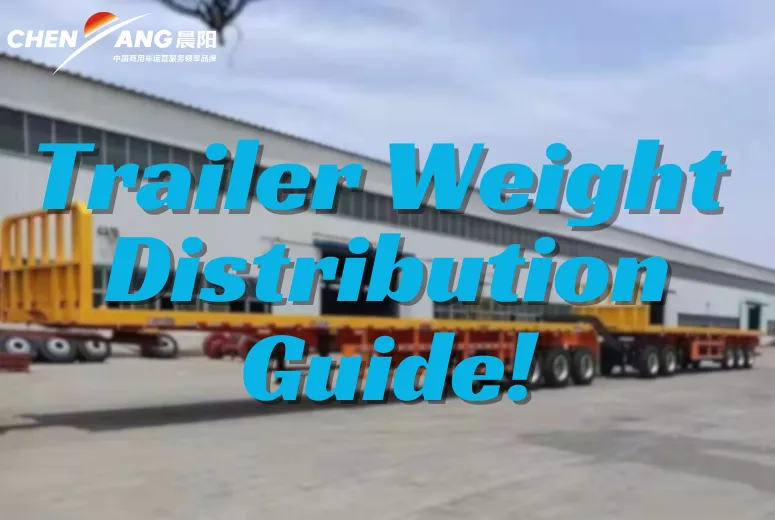A Guide to Trailer Weight Distribution and Towing Safety
Towing a trailer requires more than just attaching it to your vehicle and hitting the road. Proper weight distribution and a keen focus on safety are crucial for a smooth and secure towing experience. Whether you’re hauling heavy equipment or taking a travel trailer on vacation, understanding these principles is essential to prevent accidents and improve overall handling.

Understanding the Importance of Weight Distribution About Trailer
Weight distribution affects everything from braking performance to fuel efficiency. Poorly distributed weight can lead to sway, reduced traction, and instability. The goal is to ensure that the weight of the motorcycle trailer is evenly balanced to avoid overloading specific areas, which can compromise both the trailer and the towing vehicle.
A common rule of thumb is the 60/40 rule: about 60% of the trailer's weight should rest toward the front, near the hitch, and the remaining 40% toward the rear. This arrangement improves tongue weight—the downward force on the hitch—ensuring proper control and reducing the likelihood of fishtailing.
Tools and Techniques for Proper Weight Distribution About Trailer
Weight distribution hitches are invaluable for achieving balance and stability. These hitches redistribute the weight between the enclosed trailer and the tow vehicle's axles, reducing strain on the rear suspension and improving steering control. Installing a sway control bar alongside these hitches further minimizes side-to-side movement caused by crosswinds or sharp turns.
Another effective technique is adjusting the placement of cargo within the trailer. Heavier items should be positioned low and near the center, preventing the trailer from becoming top-heavy. Lighter items can be stored higher or at the back, ensuring that weight remains concentrated in the optimal areas.
Ensuring Towing Safety on the Road With Trailer
Safety starts with thorough preparation before you even start your journey. Conducting a pre-trip inspection is vital. Check tire pressure, wheel lug nuts, and lighting systems to confirm everything is functioning correctly. Underinflated or overinflated tires can lead to blowouts, while faulty lights pose a risk to visibility and communication with other drivers.
When driving, maintain a safe speed and allow for longer stopping distances. Trailers add significant weight to your vehicle, and sudden braking can lead to jackknifing or trailer sway. Always use gradual, steady pressure on the brakes and avoid abrupt steering maneuvers.
Staying aware of road conditions and traffic flow is equally important. High winds, rain, or uneven roads can create challenges for towing. Adjust your driving style to accommodate these conditions, keeping a firm grip on the steering wheel and being prepared for unexpected movements.
The Role of Trailer Brakes in Safety
Trailer brakes are a key factor in maintaining control during towing. For heavier loads, electric trailer brakes provide synchronized stopping power between the trailer and the towing vehicle. Many modern systems come with a brake controller that allows you to adjust braking intensity based on the weight and condition of the trailer.
In addition to regular brakes, some trailers are equipped with emergency breakaway systems. These systems automatically engage the trailer brakes if the trailer becomes disconnected, reducing the risk of accidents. Regularly testing and maintaining these systems ensures they will function effectively when needed.
Balancing Legal and Practical Considerations About Trailer
Each state or country has regulations governing towing, including weight limits, speed restrictions, and required safety features. Ensuring compliance with these laws is critical for avoiding penalties and ensuring the safety of everyone on the road. Overloading your trailer or exceeding the towing capacity of your vehicle not only violates these laws but also puts you at risk for mechanical failures and accidents.
Practical considerations also play a role in safe towing. Familiarize yourself with your vehicle’s towing capacity, which includes both the gross trailer weight and tongue weight. Exceeding these capacities can damage the vehicle's drivetrain, brakes, and suspension. Using a weight scale to measure the loaded trailer ensures you remain within safe limits.
Preparing for Emergencies About Trailer
Even with the best preparations, emergencies can happen. Having a plan in place can make a significant difference. Carry essential tools such as a tire repair kit, spare trailer tires, and a jack suitable for the trailer’s weight. Emergency triangles and reflective vests improve visibility if you need to stop on the roadside.
Practice handling potential issues, such as how to recover from trailer sway or what to do if the trailer becomes unhitched. Knowledge and preparation can prevent panic and lead to better outcomes in high-stress situations.
-
Low Maintenance + High Availability of Ownership for Mining Dump TruckNewsJul.17,2025
-
Drum Drive Axle + Air Suspension for Electric Tractor TruckNewsJul.17,2025
-
33m Boom + Full Hydraulic Outriggers: Narrow-Site Construction Practices of Mixer Pump TruckNewsJul.17,2025
-
18L Large Drum + Extended Drain Interval of Gear Oil for Heavy Duty TrucksNewsJul.17,2025
-
13m Cargo Space + Polyurethane Insulation: Long-Term Cold Chain Protection Solutions for Refrigerated Semi-Trailers for SaleNewsJul.17,2025
-
10T Water Tank + 2.5MPa Fire Pump Efficiency Analysis of Water Tank Fire TruckNewsJul.17,2025
Popular products

























